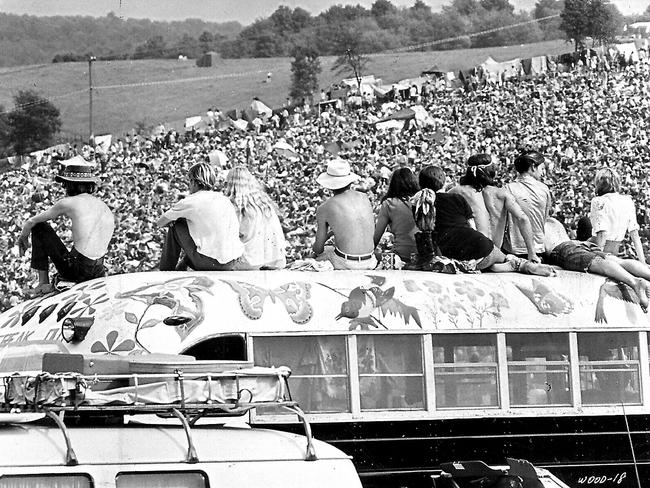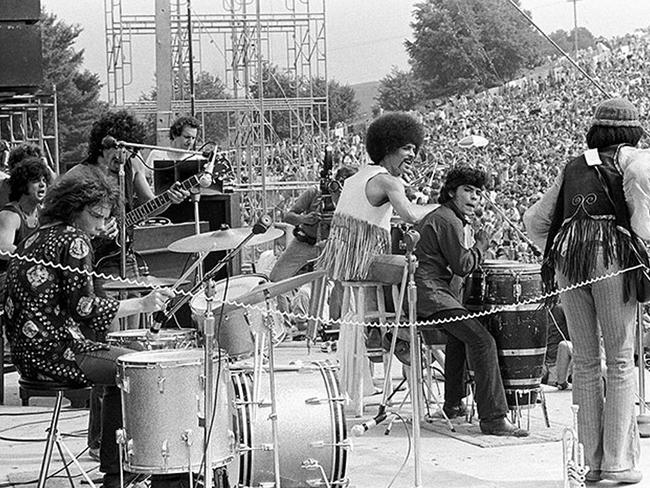Woodstock festival defied its chaos to define a generation
The town of Bethel had never seen so many people but it became the setting for a generation defining moment in rock history
Today in History
Don't miss out on the headlines from Today in History. Followed categories will be added to My News.
It was a crowd unlike any the small semi-rural community of Bethel, about 160km north of New York City, had ever seen. The town had hosted festivals and concerts before but only with a few hundred
or a few thousand people.
But 50 years ago today about half a million people were camped on a farm owned by Max Yasgur to listen to some of the hottest acts in rock music at the time. It was all part of an “Aquarian Exposition” billed as “3 Days of Peace and Music” from August 15-18, 1969. Although it will forever be known as the Woodstock festival, it was actually about 100km from Woodstock.
Organised by four men, only one of whom had any experience of putting together a rock festival, it soon grew larger than they could ever have dreamt and although things started to go wrong the concert was, in its own chaotic way, a great success if only because it was a magic moment in time that seemed to sum up an era by bringing so many people together in one place with a shared purpose — to celebrate the best musical artists of the time and show that they were a generation who would not be dictated to by the past.

It was an era when young people railed against the conservatism of
the past. They grew their hair, experimented with drugs, dabbled in alternative ideas and became more political, especially over the issue of opposition to the Vietnam War.
Popular music reflected this and bands began sharing the bill at large open-air concerts or festivals.
Woodstock began with an idea for something other than a concert. In January 1969, John Roberts and Joel Rosenman, partners in a successful New York recording studio, were approached by concert promoter Michael Lang, and musician turned record producer Artie Kornfeld, to discuss setting up a recording studio in Woodstock. Since the early 1900s the town had been home
to artists and musicians in retreat from New York and had often hosted concerts and
arts festivals. More recently it had become home to pop musicians,
among them Bob Dylan.
Lang and Kornfeld believed the presence of so many musicians
in the area would make the studio a success. They hoped Dylan would play at a launch concert.

Lang was the only one who knew anything about music festivals. He had produced several small events in Florida, culminating in the 1968 Miami Pop Festival, held at a horse racing track, which despite being cut short by rain was moderately successful.
For Woodstock Lang wanted to move from urban racetrack to the countryside. But finding a venue proved problematic. He found a property in Woodstock, but it was too small. Another in the nearby town of Saugerties fell through when the owner had second thoughts. The men looked at a site in Walkill, slated for development as an industrial park but the local council worried about the disruption. Only a month away from the concert Yasgur came to the rescue, offering his property.

Meanwhile, the promoters had been trying to sign acts. Dylan had refused and they were finding it hard to attract headline acts, until Creedence Clearwater Revival signed on, after which others joined the line-up. Soon they had The Who, Jimi Hendrix, The Grateful Dead and Crosby, Stills, Nash and Young on the bill.
The logistics still hadn’t been properly sorted out when concertgoers started arriving. Without proper fencing and security, thousands walked in and set up camp. Lang and his partners lost a fortune in ticket sales when they were forced to declare the event free. The roadways into Bethel were choked and some music fans walked for miles to get to the grounds while thousands more had to turn back. The scheduled opening act Sweetwater was delayed by the jam and Richie Havens ended up going on first.

Rain poured down on the first day, turning the field into mud and altering the schedule as some musicians refused to play in the rain. As the festival wore on there were problems with toilets and sanitation and food shortages. Warnings were given to audience members about bad drugs.
But despite the problems the festival was relatively peaceful. Two people died, one from a medical problem the other from a tractor accident, and two babies were born.
The final act was Hendrix, whose rendition of the Star Spangled Banner awed the audience. But by the time he took the stage, delayed by rain, thousands had left. The promoters initially lost money, but made it back on film and recording rights.
Originally published as Woodstock festival defied its chaos to define a generation

